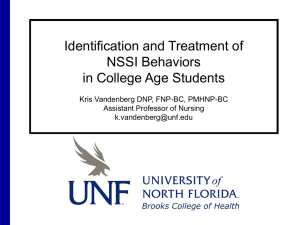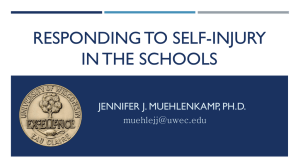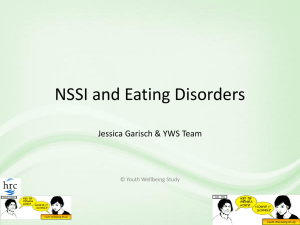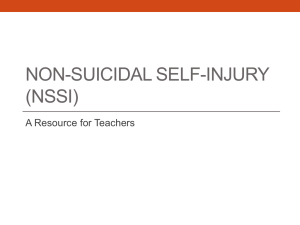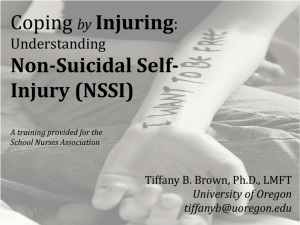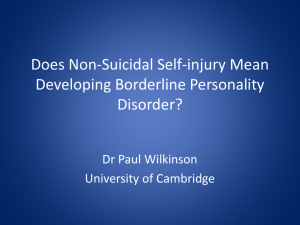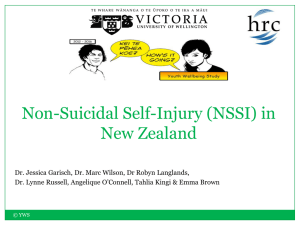Suicide and Non-Suicidal Self-Injury in Adolescents
advertisement
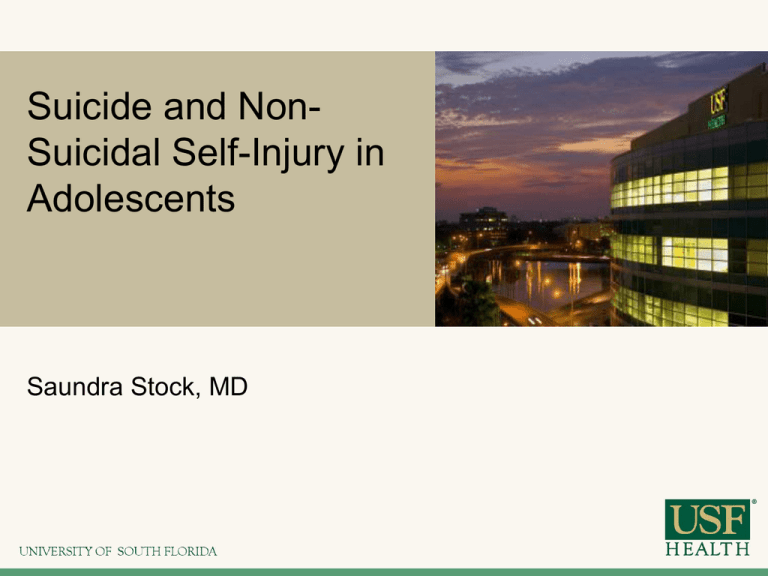
Suicide and NonSuicidal Self-Injury in Adolescents Saundra Stock, MD Suicide CDC - 17% of adolescents think about suicide each year Thoughts of death part of MDE 3rd leading cause of death in adolescents about 2,000 deaths per year 25% decline in suicide rate in 10-19 year range in past decade Suicide attempts often impulsive in nature FDA warning FDA reviewed 23 studies with 9 different meds > 4,300 pts NO SUICIDES in these studies Adverse events reporting - SI or potentially dangerous behavior reported by 4% of pts on meds vs. 2% on placebo 17 of 23 studies asked about SI - no new SI or worsening of SI, actually decreased during treatment Meta Analysis of 27 RCTs with SSRIs Studies were for MDD, OCD and non-OCD anxiety For MDD – NNT = 10 – NNH = 112 More effective and less SEs when treating OCD or non-OCD anxiety JAMA 2007 Suicide and SSRIs FDA black box warning for risk of suicide for all ages with ALL antidepressants Need to advise families about this risk and give crisis info FDA recommended – Weekly contact the first 4 weeks – Every other week through week 12 – As indicated after week 12 Suicide and SSRIs FDA changed black box warning from specific monitoring to more general one All patients being treated with antidepressants for any indication should be monitored appropriately and observed closely for clinical worsening, suicidality, and unusual changes in behavior, especially during the initial few months of a course of drug therapy, or at times of dose changes, either increases or decreases. Treating Adol Suicide Attempters Study (TASA) Youth Most likely to re-attempt suicide Higher level of suicidal thoughts Higher level self report of depressive sx’s esp hopelessness and anxiety 2 or more prior attempts Low lethality of index attempt H/o maltreatment Low family cohesion Avg time to re-attempt 6 weeks MDD trials ADAPT, TADS and TORDIA have not shown great results for CBT in reducing risk of suicide attempts or NSSI Family therapy may be helpful Groups CBT and DBT, perhaps some reduction in risk General advice for families regarding SI No firearms in home Limit access to medication including over the counter meds Remove access to parent’s medications Remove razors from bathroom or other sharps Increase supervision (e.g. keep doors open, limit peer contact to with adults present) Importance of seeking help if suicidal thoughts develop or worsen Crisis numbers (234-1234), emergency room resources and 911 NSSI and link to suicide Suicide is the 3rd leading cause of death in adolescents 90% of youth who suicide have a psychiatric disorder – The largest group (35%) have MDD – Previous self harm is present in 40% of youth who suicide Several large studies now with youth and MDD looking at treatment options and outcomes: TADS, TORDIA, ADAPT TORDIA and SI/NSSI 354 youth with MDD – 23.9% NSSI baseline – 9.5% SA – 14% NSSI + SI Over 24 weeks 13% with NSSI made a suicide attempt vs 3% with prior SA 11% had NSSI over the 24 weeks (more common than a SA Predictors of SA were NSSI and hopelessness Tordia study JAMA 2008 Switch SSRIs Pts ages 12-18 failed 2month SSRI trial N= 334 Paroxetine Fluoxetine Citalopram 47% improved Switch SSRI + add CBT Better outcome 54.8% Switch to venlafaxine 48.2% improved Switch to venlafaxine + CBT Better outcome 54.8% Non-Suicidal Self Injury (NSSI) Intentional destruction of one’s body tissue without suicidal intent & for purposes which are not socially sanctioned Common methods: 70%-90% of people who self-injure engage in skin cutting, scraping, or carving 21-44% banging, bruising, and self-hitting 15-35% burning Klonsky, E. David; Muehlenkamp, Jennifer J.; Lewis, Stephen P.; Walsh, Barent (2012-06-25). Nonsuicidal Self-Injury (Advances in Psychotherapy, Evidence Based Practice) NonSuicidal Self-Injury “Condition for further study” in DSM 5 A. 5 or more episodes in 1 year B. 2 or more • Preceded by negative affect • Prior to engaging in the act, a period of preoccupation with the intended behavior that is difficult to resist. • The urge to engage in self-injury occurs frequently, although it might not be acted upon • The activity is engaged in with a purpose; maybe relief from a negative feeling/cognitive state or interpersonal difficulty or induction of a positive feeling state. The patient anticipates these will occur either during or immediately following the self-injury. C. Behavior and consequences cause distress D. Not exclusively during intoxication or psychosis Epidemiology 10-15% teens have self-injured at least once – Most studies find 6-8% of teens and young adults reporting current, chronic self-injury – More common in clinical populations Self-injury typically begins at ages 12-15 years M=F lifetime rates, however females may engage in NSSI more often Females tend to cut; Males hit or bang More comon in Hispanic or Native American in US studies. UK study found more in Asian decent Biology – little is known Endogenous opioids (mixed evidence) – Released with physical injury and may explain positive emotions and limited pain – Studies with naloxone (opioid antagonist) negative Serotonin: animal models with low serotonin engage in self injury. Also low with aggression and suicidal behavior ? Dopamine: reduced in Lesch-Nyhan No differences on phsiologic measures of emotional responses compared to controls Course and Prognosis Occurs with a wide range of diagnoses Few longitudinal studies of NSSI exist Questions to be answered: – How many people stop NSSI and when? – Is NSSI a precursor to specific mental disorders? – How often does it lead to suicidal behavior? Some information on NSSI and sucide attempts from several large studies on depression in adolescents TORDIA and SI/NSSI 354 youth with MDD – 23.9% NSSI baseline – 9.5% SA – 14% NSSI + SI Over 24 weeks 13% with NSSI made a suicide attempt vs 3% with prior SA 11% had NSSI over the 24 weeks Predictors of SA were NSSI & hopelessness ADAPT study Original trial N=208 British teens with moderate to severe depression randomized to SSRI or SSRI + 12 weeks of CBT. Outcome at 28 weeks found no difference btwn treatment groups. Subsequent analysis looked at those at risk for suicide attempt ADAPT study N= 163 teens 11-17 yrs Suicide attempt in 28 week f/u period – 30% made a SA, lower each month – Risk factors: +SI, depression severity, hopelessness, NSSI or SA in the month before baseline and impaired family functioning NNSI – 37% had self injury, lower each month – Risk factors: NSSI in month prior to study, depression severity, anxiety, hopelessness, female and younger age ADAPT: suicide attempts & self injury N= 163 teens 11 to17 years (mean age 14) Avg 67 weeks of depression – CDI score mean 59.9 One month prior to the study – 28 (17%) had made SA – 58 (36%) had engaged in NSSI During the 28 weeks of the study – 50 (30%) youth made a SA – 60 (37%) youth engaged in NSSI ADAPT study results Suicide – NSSI a stronger predictor of suicide attempt than a prior suicide attempt – 10 fold greater risk of suicide attempt than those who had no self injury and good family functioning NSSI – 36% had NSSI the month prior to the study and 37% engaged in NSSI during the study period. – Most significant predictor of subsequent self injury was prior self injury ADAPT self-injury Compared with suicidality, self-injury over the 24 week follow- up period was associated with a different pattern of predictors. – Poor family functioning was not associated with self-injury (but was associated with suicide attempts) – Hopelessness & anxiety disorder at baseline along with being both younger and female, were associated with self-injury but not with suicidality. ADAPT suicide risk factors A higher risk of suicide attempt during follow-up significantly associated with suicidality, depression severity, hopelessness, the presence of a suicide attempt or self- injury in the month before baseline, and impaired family functioning Multiple logistical regression revealed impaired family functioning and self injury were significantly associated with suicide attempt ROC4 analysis showed self-injury to be the strongest predictor of suicide attempt Assessment of NSSI: implications for intervention Age of onset Methods used for NSSI & access to those materials Frequency & interval from thoughts to action Last self-injury Location of injury and medical severity Thoughts before, during and after NSSI Function of behavior (intra or interpersonal) Assessment measures Self-Injurious thoughts and behavior interview (SITBI) Suicide Attempt Self Injury Interview SASII (Linehan) Suicide Behavior Questionairre (SBQ Linehan) Both Linehan assessment items online at http://blogs.uw.edu/brtc/publications-assessmentinstruments/ Concern for teens: all ask specifics about actions which they may not have thought of yet Function of NSSI Most common are INTRApersonal reasons 1. To regulate emotions • • Release emotions, calm down, stop numb feelings Reduces high arousal emotions (anger, anxiety, frustration) more than low arousal (i.e. sadness) 2. Self punishment Sometimes INTERpersonal – – Interpersonal influence: “letting others know how I feel” “getting back at someone” or getting out of repsonsibilties Peer bonding: “fitting in” Interventions for NSSI Few studies in adolescents looking at strictly NSSI Therapy that focuses on: – Emotion regulation – Problem solving – Improved self esteem DBT, CBT or problem based Research has repeatedly documented that people who engage in NSSI have more frequent & intense negative emotions as well as poorer global emotion regulation skills Level of intervention Ongoing monitirong only might be appropriate if: only 1-2 episodes of NSSI Outpatient TX: consider if > episodes of NSSI, intrapersonal reasons, multiple methods used, SI present at times, NSSI performed alone Inpatient TX: high frequency/urgency to thoughts or NSSI, high medical severity, ongoing +SI present as well Improving Emotion Regulation Several therapies which accomplish this Essential components: – Emotion psychoeducation • Label emotions, context they occur and function served including adpative aspect of + and – emotions – Reducing emotional vulnerabilities • Sleep, eating and exercising – Improving distress tolerance • Distraction or relaxation techniques; replacements if needed – Increasing positive emotional experiences Problem Solving Typical steps include: – Identifying the problem – Identifying the goal – Generating/brainstorming solutions – Evaluating solutions and potential outcomes – Implementing a solution – Reassessing effectiveness after implementation Problem Solving Nock 2008 found adolescents with NSSI generated as many options to problems as adolescents without NSSI Adolescents with NSSI selected negative options more often Adolescents with NSSI rated their selfefficacy lower Therefore, may need more focus on later steps in problem solving for youth with NSSI Nock: Journal of Consulting and Clinical Psychology 2008, Vol. 76, No. 1, 28–38 Interpersonal skills: a means to increase self esteem/self efficacy Less effective at communication skills and seeking help from others People experience increased social support following self-injury (including suicide attempts) One study with preadolescents found improved father-child relationship in the 18months following NSSI Family therapy: high levels of parental expressed emotions and criticism for adol with NSSI (N=36) New directions: Motivational interviewing Suggested as a means to help reduce NSSI 5 core elements for therapy – Expressing empathy – Avoiding argumentation (not insisting on as a target based on person’s interest in change) – Rolling with resistance – Supporting self-effcicacy – Developing discrepancy (help pt ID that there is a gap from where they are & want to be) References Bridge JA, Goldstein TR, Brent DA: Adolescent suicide and suicidal behavior. J Child Psychol Psychiatry 2006; 47:372–394 Cavanagh JT, Carson AJ, Sharpe M, Lawrie SM: Psychological autopsy studies of suicide: a systematic review. Psychol Med 2003; 33:395–405 Cooper J, Kapur N, Webb R, Lawlor M, Guthrie E, Mackway-Jones K, Appleby L: Suicide after deliberate self-harm: a 4-year cohort study. Am J Psychiatry 2005; 162:297–303 Glenn CR Emotional Reactivity in Nonsuicidal Self-injury: Divergence Between Self-Report and Startle Measures Int J Psychophysiol 2011 May 80(2): 166-170I Brent DA et al. Predictors of spontaneous and systematically assessed suicidal adverse events in the Treatment of SSRI-Resistant Depression in Adolescents (TORDIA) study. Am J Psychiatry 2009; 166:418–426 Goodyer I et al Selective serotonin reuptake inhibitors (SSRIs) and routine specialist care with and without cognitive behaviour therapy in adolescents with major depression: randomised controlled trial. BMJ 2007; 335:142 References Wilkinson P et al. Clinical and Psychosocial Predictors of Suicide Attempts and Nonsuicidal Self-Injury in the Adolescent Depression Antidepressants and Psychotherapy Trial (ADAPT) Am J Psych Feb 2012 Nonsuicidal Self-Injury (Advances in Psychotherapy, Evidence Based Practice) Klonsky, E. David; Muehlenkamp, Jennifer J.; Lewis, Stephen P.; Walsh, Barent (2012-06-25). Nock MK, Mendes WB. Physiological Arousal, Distress Tolerance, and Social Problem–Solving Deficits Among Adolescent SelfInjurersJournal of Consulting and Clinical Psychology 2008, Vol. 76, No. 1, 28–38 Wedig MM and Nock MK Parental Expressed Emotion and Adolescent Self-Injury J. Am. Acad. Child Adolesc. Psychiatry, 2007;46(9):1171Y1178.
